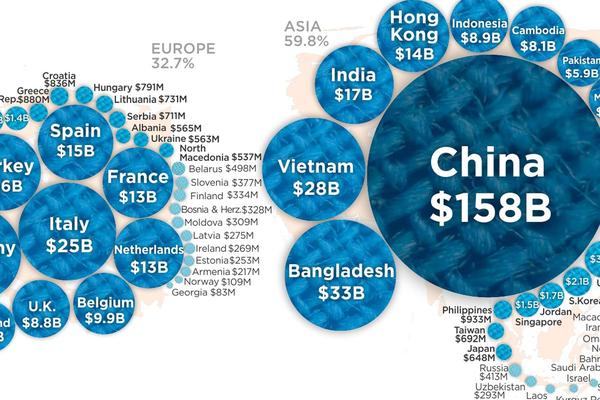The countries that export the most clothes to the rest of the planet, illustrated on a map
Subscribe to Magnet
Receive an email a day with our articles:
The textile industry is one of the economic pillars of the 21st century. The relocation of factories to Southeast Asian countries, mainly China, has revolutionized the way we consume clothing. Today accessing a designer jean or shirt is simple and costs very little money, thanks in large part to declining labor and manufacturing costs in still-developing countries.
The way we produce and purchase clothing helps explain many aspects of contemporary politics, culture, and economics. From the bitter protest of numerous groups against globalization to the ability of poor families to afford immediate consumer products. Trends that crystallize in three words integrated into the popular imagination for some time now: "Made in China".
When we think of our favorite sweater or sneakers, bought at Zara or Mango, we are imagining a garment made in China. The Asian giant continues to be the champion of the textile industry, despite the fact that other countries have monopolized a greater percentage of world production in recent years. China exports $150 billion worth of textile goods annually.

No other country comes close.
This map is perfectly illustrated by How Much, the website dedicated to explaining the economy of our time through simple visualizations. It shows the disproportionate size of China compared to other countries. Its closest rival, Bangladesh, barely exports a fraction of the economic value that China generates each economic year: $33 billion. Vietnam tops the podium with $28 billion.
The illustration is interesting because it shows the resistance of the European textile sector, more focused on high added value products than on fast fashion, but equally powerful. Italy, of course, leads the continent with exports worth $25,000 million. It is followed by Germany ($24 billion, partly due to the repatriation of production lines and the new logistics strategies of Adidas, now in crisis).
Sixth on the list is India ($17 billion), followed by a trio of second-tier European countries, but with still impressive figures: $16,000 for Turkey, $15,000 for Spain and $13,000 for France. Its prominence shows that the textile sector continues to be important for the continent, something that cannot be said of the United States, for example, whose exports barely represent a fraction of its gigantic economy, the largest on the planet ($6 billion annually).
Such figures, especially those of China, can only be sustained by a consumer culture that prioritizes cheap and short-lasting garments over more durable ones. The problems facing the textile industry, both at an immediate and reputational level, are varied. Its environmental footprint is the second highest of all activities on the planet, and its pollution levels in Asia are unsustainable.
To all this we must add the still suspicious practices regarding employability, not only in countries like Bangladesh or Brazil, but also on European soil, as the Italian example demonstrates. But his business, today, continues to go from strength to strength at full sail. We continue to buy more clothes than ever before (and reuse very, very little of it, which adds to the environmental problem).
Share The countries that export the most clothes to the rest of the planet, illustrated on a map
Share




